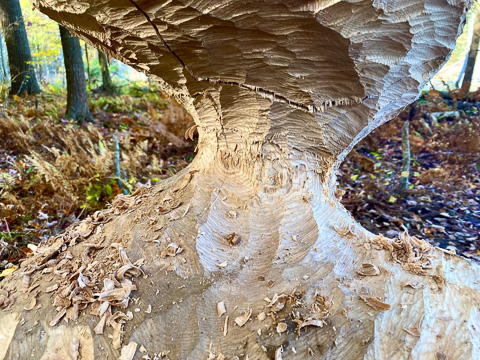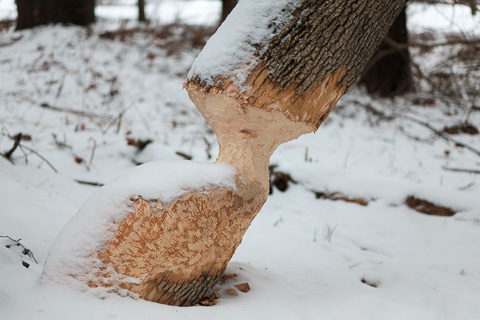
Beaver-Eaten Trees
As you explore this area, you’re sure to encounter the tell-tale mark of the creatures who have transformed Emmons Pond. Nature's hydro-engineers, Beavers profoundly shape their environments as they build dams, raise the water-level and down trees for food and construction materials.
Ask a biologist: Why do the beavers chew down such large trees?
Donna Vogler: “There are probably at least a couple of family groups here and they’re hungry. They’re feeding and taking down a lot of timber to eat. Beaver prefer the outer cambium of a tree so they especially like the tender branches. They’ll carve down the woody parts to get to them because they can’t climb so they don’t really eat the wood that they’re chewing on. They’re not eating this for the nutrition when they cut down a tree. When the branches come down, that’s what they eat for their nutrition. They’ll take down a lot of trees. Then in the wintertime, they’ll chew off some of those branches, bring them back to their lodge, and eat that cambium layer around it. There’s also muskrats, which eat a lot of the roots of these plants. Muskrats and beaver tend to go together because when the beavers make the dam, the muskrats move in to feed.”
Ask a Biologist: What are their favorite trees to eat?
Donna Vogler: “One thing that they have taken a lot of is quaking aspen (Populous tremuloides). There used to be a large patch of aspen here, which is a colonial species. This is one of their favorite foods. We used to have a lot of it around here, but that’s now long gone. Just like us, you know, you open the refrigerator, you eat the good stuff first and then you kind of work your way through the leftovers. They went for the aspen first. This was a pretty tough aspen grove and you couldn't see the bog through it. When the beavers moved in, they took out the aspen and now we can see the bog.”

Beaver Fun Facts
- During the Ice Age, beavers weighed up to 200 pounds.
- Beavers have yellow teeth.
- Beavers are monogamous.
- The tail of a beaver has multiple uses. When swimming, it acts as a rudder to steer. It can also be used to slap the top of the water making a loud noise to alarm other beavers of danger.
- Beavers are a keystone species.
- Beavers use various kinds of trees for different purposes. Large, older trees are used to make dams. Young trees are used as food. .
- Throughout the year, beavers stock food in their dens to last them through the winter. Sometimes, the water the beavers are living in will completely freeze over, trapping them in their dens. If the beavers have enough food stored, they will be able to survive.